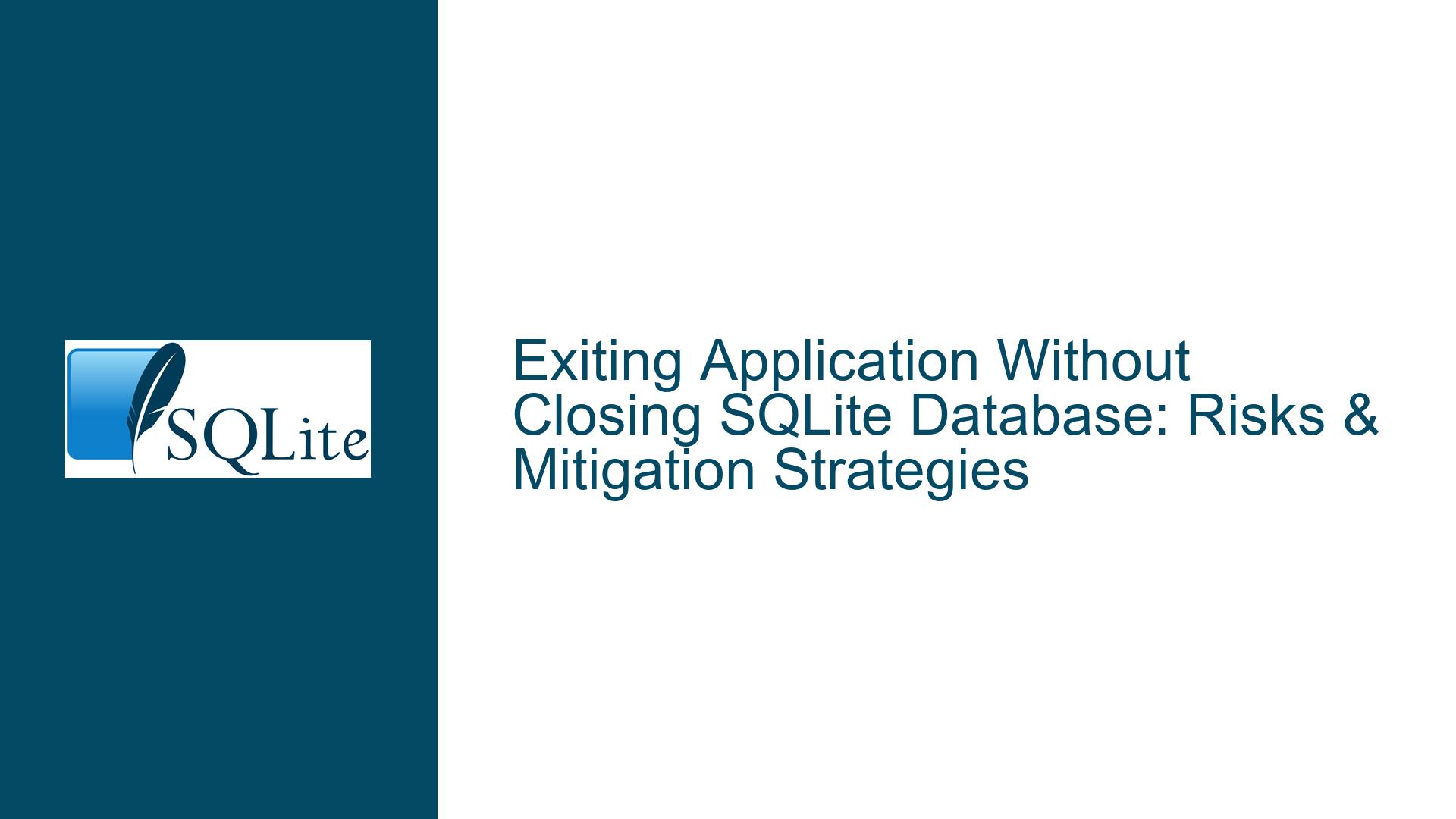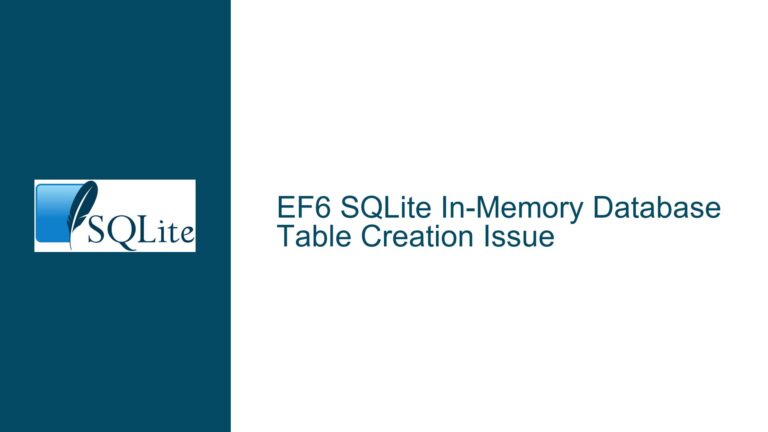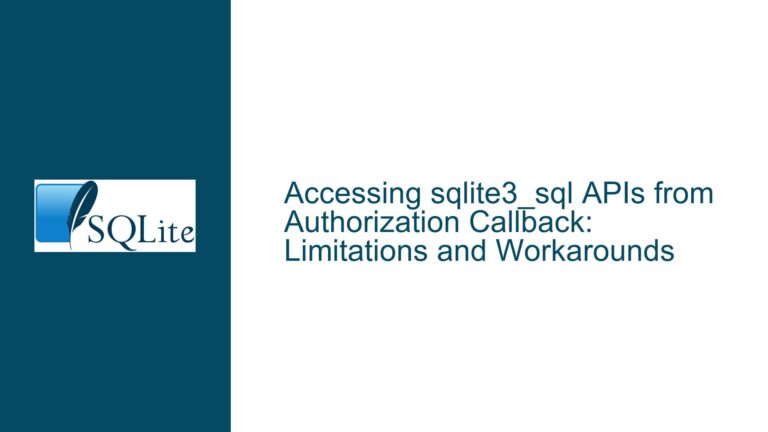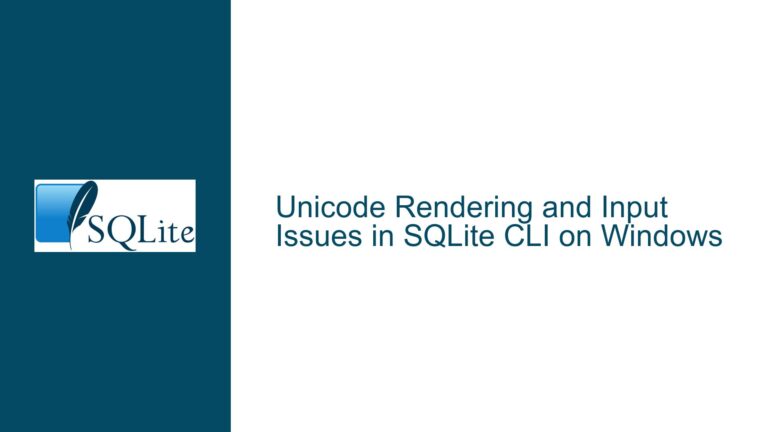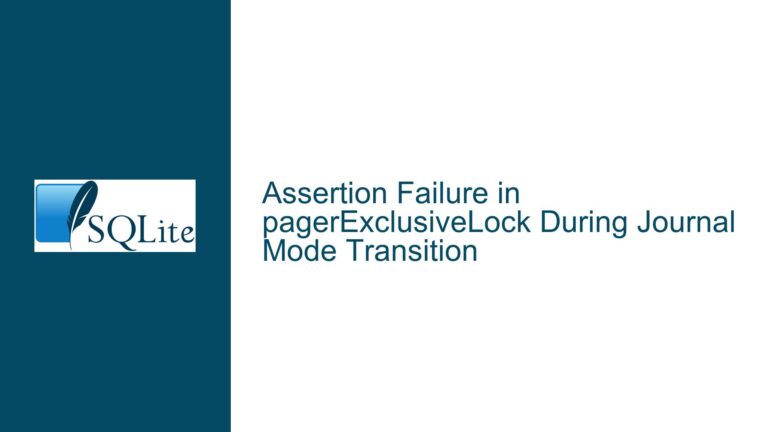Exiting Application Without Closing SQLite Database: Risks & Mitigation Strategies
Understanding SQLite Database Closure Behavior During Application Termination
Issue Overview: Implications of Unclosed Database Connections at Application Exit
When an application terminates without explicitly closing its SQLite database connections, developers often worry about data integrity risks such as corruption, incomplete writes, or inconsistent states. This concern arises from uncertainty about how SQLite manages resources during abrupt exits and whether the operating system’s cleanup mechanisms are sufficient to prevent data loss.
In the context of Go applications using the go-sqlite3 driver, which wraps SQLite’s C API, the problem is compounded by language-specific challenges such as handling signals (e.g., SIGINT, SIGTERM) and third-party code that might forcibly terminate the process (e.g., os.Exit or log.Fatal). The SQLite C function sqlite3_close_v2 is designed to finalize database connections, but its invocation depends on the application’s ability to execute cleanup logic before termination.
Key questions include:
- Does SQLite guarantee atomic transactions even if the database connection is not closed?
- How does the operating system’s resource reclamation interact with SQLite’s write-ahead logging (WAL) or rollback journal?
- Are there scenarios where failing to close the database explicitly could leave it in an unrecoverable state?
SQLite’s durability mechanisms, such as its transaction ACID properties and file locking, play a critical role here. When a process exits, the operating system releases all file handles and memory resources, which includes flushing buffered writes to disk (subject to filesystem semantics). However, this process is not equivalent to a graceful SQLite shutdown, where pending transactions are rolled back, and the WAL or journal files are cleaned up.
Possible Causes of Data Integrity Issues from Unclosed Connections
Open Transactions at Exit:
If the application exits while a transaction is active (e.g., afterBEGINbut beforeCOMMIT), SQLite’s rollback journal or WAL file may retain uncommitted changes. Upon the next connection, SQLite will attempt to recover by rolling back the transaction. However, if the journal/WAL is corrupted due to an incomplete write, recovery may fail.Unflushed Write Operations:
SQLite employs buffered I/O to improve performance. Writes are staged in memory or the OS page cache before being flushed to disk. If the application exits before these writes are flushed, data loss can occur. While the operating system typically flushes caches on process termination, this is not guaranteed in all environments (e.g., power loss, kernel panics).File Locking Contention:
SQLite uses file locks to manage concurrent access. If a process exits without releasing locks (e.g., due to an unclosed connection), other processes may interpret the lingering locks as evidence of an active connection, leading to delayed write operations orSQLITE_BUSYerrors.Signal Handling and Forced Termination:
In Go,deferstatements are not executed when the application receives certain signals (e.g., SIGKILL) or callsos.Exit. This bypasses cleanup routines, leaving database connections open. Third-party libraries that callos.Exitdirectly (e.g.,log.Fatalf) exacerbate this issue.Resource Leaks in Long-Running Processes:
While the operating system reclaims resources upon process termination, applications that function as libraries or daemons may leak file handles if connections are not closed explicitly, leading to eventual resource exhaustion.
Troubleshooting Steps, Solutions & Fixes
1. Ensure Transaction Finalization Before Exit
- Explicit Transaction Boundaries:
UseBEGIN IMMEDIATEorBEGIN EXCLUSIVEfor write transactions to minimize the window where uncommitted changes exist. Pair everyBEGINwith aCOMMITorROLLBACKin adeferblock.func updateRecord(db *sql.DB) error { tx, err := db.Begin() if err != nil { return err } defer tx.Rollback() // Safeguard against unclosed transactions // Perform database operations if _, err := tx.Exec("UPDATE table SET column = ?", value); err != nil { return err } return tx.Commit() } - Avoid Long-Running Transactions:
Break large transactions into smaller batches to reduce the risk of interruption.
2. Handle Signals Gracefully
- Intercept OS Signals:
In Go, useos/signalto capture signals like SIGINT and SIGTERM, allowing cleanup routines to execute:func main() { db, _ := sql.Open("sqlite3", "file:test.db") defer db.Close() signalChan := make(chan os.Signal, 1) signal.Notify(signalChan, syscall.SIGINT, syscall.SIGTERM) go func() { <-signalChan db.Close() os.Exit(1) }() // Application logic } - Avoid
os.Exitin Libraries:
Replacelog.Fatalfwith panic/recover mechanisms or error propagation to ensuredeferstatements execute.
3. Leverage SQLite’s Resilience Features
- Use WAL Mode:
Enable Write-Ahead Logging (PRAGMA journal_mode=WAL;) to reduce contention and improve crash recovery. WAL separates writes into a log file, which SQLite automatically replays on the next connection if the database was not closed cleanly. - Set Synchronous Modes:
ConfigurePRAGMA synchronous=NORMAL;orFULLto balance performance and durability.FULLensures writes are flushed to disk before the transaction completes, minimizing data loss risk.
4. Mitigate Resource Leaks
- Centralize Connection Management:
Use a singleton or connection pool to track all database handles, ensuring they can be closed en masse during shutdown.type DBManager struct { dbs []*sql.DB } func (m *DBManager) Open(path string) (*sql.DB, error) { db, err := sql.Open("sqlite3", path) if err == nil { m.dbs = append(m.dbs, db) } return db, err } func (m *DBManager) CloseAll() { for _, db := range m.dbs { db.Close() } } - Use
atexitHandlers:
Third-party libraries likegithub.com/tebeka/atexitcan register functions to run before program termination, though they are ineffective againstos.Exitor SIGKILL.
5. Validate Database State Post-Crash
- Integrity Checks:
RunPRAGMA integrity_check;after reopening a database to detect corruption. - Automatic Recovery Scripts:
For critical applications, implement scripts that rebuild indices or restore from backups if corruption is detected.
6. Monitor File Locking State
- Detect Lingering Locks:
On Unix systems, uselsofto check for open file handles to the database. On Windows, Process Explorer can identify processes holding locks. - Adjust Locking Timeout:
SetPRAGMA busy_timeout=5000;to allow other connections to retry operations if locks are not released promptly.
7. Test Crash Scenarios
- Simulate Abrupt Termination:
Use debuggers or kill commands to terminate the application during write operations, then verify database consistency. - Fault Injection Tools:
Tools like LLVM’slibFuzzeror SQLite’s owntestfixturecan simulate I/O errors and power failures.
8. Educate on SQLite’s Process-Cleanup Behavior
- Understand OS Guarantees:
Modern operating systems flush open file buffers to disk upon process termination unless the storage device is in asynchronous mode (e.g.,O_DIRECTin Linux). SQLite’sSQLITE_FCNTL_PERSIST_WALcontrol can further manage WAL file retention. - Distinguish Between Exit Types:
Controlled exits (e.g., SIGINT with handlers) allow cleanup, while uncontrolled exits (e.g., SIGKILL) rely on the OS.
By addressing these areas, developers can minimize the risks associated with unclosed database connections while leveraging SQLite’s built-in safeguards to maintain data integrity.
